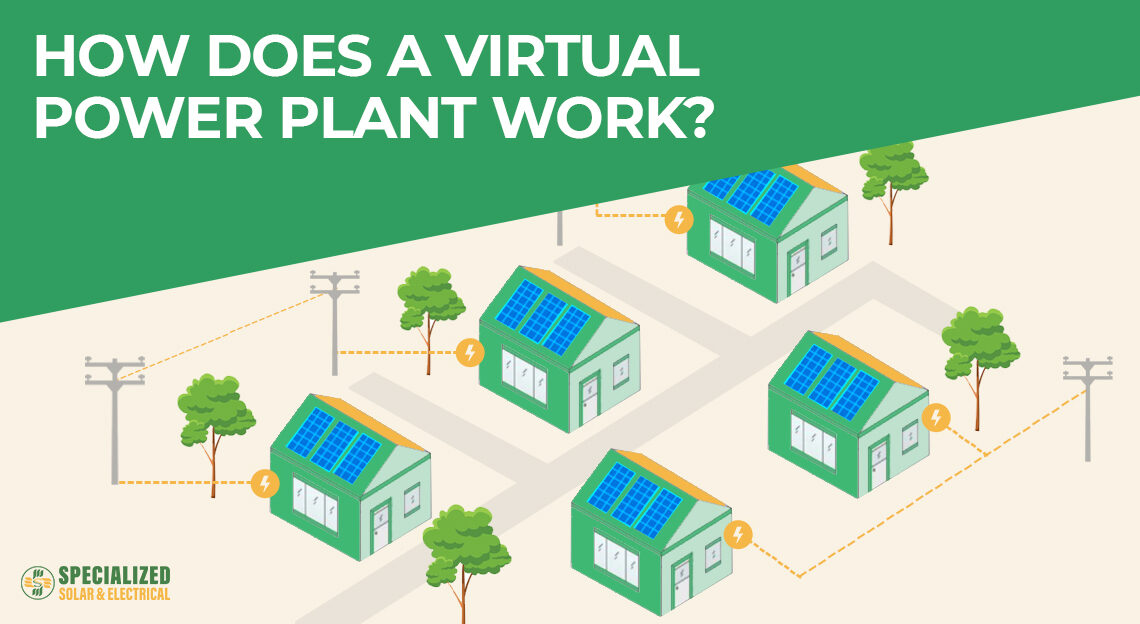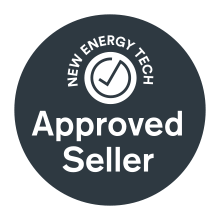A Virtual Power Plant is a network of homes with solar batteries, connected using smart software.
The purpose of a Virtual Power Plant, or VPP, is to share energy, reduce power bills and reduce reliance on the grid.
VPPs are an important step towards greater use of renewable energy in the national electricity grid. They are also an exciting opportunity for households with solar batteries to take part in energy sharing networks and receive financial benefits in return for sharing their surplus stored energy.
On this page:
- How do Virtual Power Plants work?
- What benefits do VPPs provide?
- Does it matter where I live?
- What VPPs can I join in Victoria and NSW?
How do Virtual Power Plants work?
VPPs are built on a network of hundreds, or even thousands, of homes each with their own solar panels array and solar battery.
For the VPP to work, batteries must be VPP-compatible and meet certain performance, security, and other technical standards.
Smart software is used to connect VPP-approved batteries in an energy sharing network. This network is used to help smooth out the supply of electricity flowing through the national electricity grid.
For example, on hot summer afternoons, demand for electricity peaks. People switch on their air conditioners causing a massive spike in demand.
This is when the VPP gets into action.
The VPP’s control software spots the demand spike, and immediately draws on power from batteries in its network to satisfy the demand.
The VPP receives compensation from the wholesale electricity market for satisfying the spike in network demand; and passes on a portion of this compensation to participating households.
The amount paid to households is typically more than they’d receive via the solar feed-in tariff. This is because the value of their stored solar is a lot higher when it can be called on to satisfy a peak demand event.
What benefits do VPPs provide?
VPPs provide benefits to participating households, the community, and the environment.
1. Benefits for participating households:
Households participating in a VPP benefit through reduction in power bills, and compensation for sharing their surplus solar electricity.
Each VPP program works differently. Some offer upfront discounts on the cost of a battery and ongoing financial incentives for taking part. One VPP even provides a longer battery warranty.
They all have different duration periods and exit fees so reading the fine print is important.
Also, check out:
- how often they will draw on the power in your battery
- how much power they’ll take (what percentage charge will be left in your battery)
- whether you’ll be left with enough power in the event of a blackout.
Get in touch and we can explain the pros and cons of different VPP programs.
2. Benefits for the community
The wider community also benefits from VPPs, even if they aren’t a participating battery owner. These benefits include a more reliable power supply as power outages caused by spikes in demand become less frequent. Also, the quality of power supplied to homes, businesses and other organisations will improve as VPPs can call on local batteries to address local surges in network demand.
As VPPs become more prevalent, the requirement for network distributors to ‘gold plate’ the electricity network to handle occasional demand spikes will lessen. Less expensive infrastructure upgrades will translate into lower daily electricity supply charges. This is good news for anyone who has to pay an electricity bill!
3. Benefits for the environment
Transforming the national electricity grid to a clean energy grid is essential if we are serious about tackling climate change. At present, around 75 per cent of electricity in the grid is from fossil fuels; most of that from coal-fired power stations hundreds of kilometres away from our homes.
Transporting that dirty power all the way across our states and territories doesn’t make financial or environmental sense any longer. Now that we have millions of homes and businesses with rooftop solar, tapping into that clean energy source is better for the environment and better economically.
Does it matter where I live?
VPPs are spring up right across Australia. Chances are, no matter where you live, there’s a VPP program you can join.
Some state governments, like the Victorian Government, organise approved VPP programs which comes with a greater level of customer protections and larger government battery rebates.
It’s a fast-moving area, with some great VPPs providing tried-and-tested batteries and terrific customer benefits. As battery experts, we’re right across this developing space so get in touch to find out what’s new in your region.
What VPPs can I join in Victoria and NSW?
In Victoria, there are several government-approved Virtual Power Plant Pilots that launched at the end of December 2021.
Join one of these approved VPPs and you get a boosted government battery rebate of $4,174, available to eligible households until 30 June 2022.
The Victorian Government, through their Solar Homes Program, has vetted these VPPs for:
- their quality
- customer service
- ability to increase energy affordability for participating households
- focus on strong consumer protections.
Our recommendation
Our recommendation is the Tesla Energy Plan with the Tesla Powerwall.
Why?
- Because it provides attractive financial benefits
- There’s transparency about how many times the Tesla VPP will draw on your battery
- You get an extra 5-years product warranty on your Powerwall.
So, with the Tesla Energy Plan from Tesla, you get a 15-year product warranty on the Powerwall. This is hands-down the best battery warranty on the market right now!
The Tesla Energy Plan is also available to NSW households.
Get in touch
Each VPP offers different benefits so it’s worth talking to us to find out more. Get in touch for expert battery advice, an obligation-free quote and the latest on VPPs in your state.












